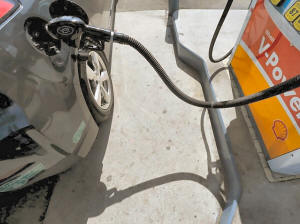|
U.S. motorists wasted billions on premium
gasoline last year: AAA
 Send a link to a friend
Send a link to a friend
 [September 20, 2016]
By Jarrett Renshaw [September 20, 2016]
By Jarrett Renshaw
NEW YORK (Reuters) - U.S. consumers wasted
billions of dollars last year filling their cars with costly
premium-grade gasoline for no tangible benefit, according to a study by
the country's leading motorist advocacy group.
The report by Heathrow, Florida-based AAA comes as low pump prices and a
growing economy enticed U.S. motorists to buy more premium-grade
gasoline in June than in any month since 2003, according to the U.S.
Energy Information Administration.
While an overwhelming majority of cars on U.S. roadways are designed to
consume regular gasoline, the study found that motorists still use
premium-grade in the hopes of achieving more horsepower and better fuel
economy. As a result, U.S. drivers spent an estimated $2.1 billion extra
by using premium gasoline in vehicles designed for regular fuel.
Premium provides little or no benefit to cars designed to run on lower
octane, regular gasoline, the study said.
“Drivers see the ‘premium’ name at the pump and may assume the fuel is
better for their vehicle,” John Nielsen, AAA’s managing director of
automotive engineering and repair, said in a statement.

“AAA cautions drivers that premium gasoline is higher octane, not higher
quality, and urges drivers to follow the owner’s manual recommendations
for their vehicle’s fuel.”
What distinguishes premium from other grades is its increased ability -
expressed in octane - to resist premature detonation, or knocking, as it
is compressed in the engine before ignition.
Premium gas is used in high-compression engines so it is often
associated with high-performance sportscars or luxury vehicles. Last
week, a gallon of premium gasoline was selling on average 48 cents
higher than regular gasoline, among the widest spreads since 1994, EIA
data shows.
[to top of second column] |

A car is filled with gasoline at a gas station pump in Carlsbad,
California August 4, 2015. REUTERS/Mike Blake

Refiners such as Royal Dutch Shell have focused on premium gasoline
sales due to healthy margins and its rising popularity.
In June, 45.3 million gallons of premium gasoline was sold, the most
in any month since 2003, according to EIA. Sales of premium
gasoline, which make up less than 15 percent of U.S. gasoline sales,
have increased at a faster rate than sales of regular gasoline in
recent years.
AAA tested 87-octane (regular) and 93-octane (premium) gasoline in
vehicles with a V-8, V-6 or I4 engine designed for regular-grade
fuel. The testing found no significant increases in horsepower and
fuel efficiency.
The survey found that 70 percent of U.S. drivers own a car requiring
regular gasoline, while 16 percent drive cars that require premium
fuel. The remaining 14 percent require mid-grade gasoline or an
alternative source.
(Editing by Bernadette Baum)
[© 2016 Thomson Reuters. All rights
reserved.]
Copyright 2016 Reuters. All rights reserved. This material may not be published,
broadcast, rewritten or redistributed.
 |